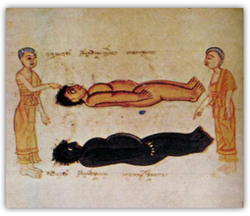|
Maraṇasati
 Maraṇasati (mindfulness of death, death awareness) is a Buddhist meditation practice of remembering (frequently keeping in mind) that death can strike at any time (AN 6.20), and that we should practice assiduously (appamada) and with urgency in every moment, even in the time it takes to draw one breath. Not being diligent every moment is called negligence by the Buddha (AN 6.19). In the earliest discourses of the Buddha, the term 'Maranasati' is only explicitly defined twice, in the two suttas AN 6.19 and AN 6.20. Later Buddhist schools have expanded the meaning of 'maranasati' to include various visualization and contemplation techniques to meditate on the nature of death. The cultivation of Maranasati is said to be conducive to right effort, and also helpful in developing a sense of spiritual urgency (Saṃvega) and renunciation (Nekkhamma).[1] Theravada BuddhismMindfulness of death is a common practice in Southeast Asian Buddhist monasteries.[1] Buddhist monasteries such as Wat Pah Nanachat will often have human skeletons on display in the meditation hall.[2] In the Pali CanonThe Satipatthana Sutta (MN: 10) and the Kayagata-sati Sutta (MN: 119) include sections on cemetery contemplations which focus on nine stages of corpse decomposition (Pali: nava sīvathikā-manasikāra). These are:
The Satipatthana Sutta instructs the meditator to reflect thus: 'This body of mine, too, is of the same nature as that body, is going to be like that body, and has not got past the condition of becoming like that body.'  According to the Maranassati Sutta, a monk should reflect on the many possibilities which could bring him to death, and then turn his thoughts to the unskillful mental qualities he has yet to abandon. "Just as when a person whose turban or head was on fire would put forth extra desire, effort, diligence, endeavor, undivided mindfulness, & alertness to put out the fire on his turban or head, in the same way the monk should put forth extra desire, effort, diligence, endeavor, undivided mindfulness, & alertness for the abandoning of those very same evil, unskillful qualities."[5] In Buddhaghosa's VisuddhimaggaAccording to Buddhaghosa's Visuddhimagga, there are eight ways of meditating on death:
Tibetan Buddhism Mindfulness of death is a central teaching of Tibetan Buddhism: it is one of the "Four Thoughts," which turn the mind towards spiritual practice. One set of Tibetan Buddhist contemplations on death come from the eleventh century Buddhist scholar Atisha.[7] Atisha is said to have said to his students that if a person is unaware of death, their meditation will have little power.[8] Atisha's contemplations on death:
Other Tibetan Buddhist practices deal directly with the moment of death, preparing the meditator for entering and navigating the Bardo, the intermediate stage between life and death. This is the theme of the popular Great Liberation through hearing during the intermediate state (Tibetan Book of the Dead). See alsoReferences
|
Portal di Ensiklopedia Dunia
